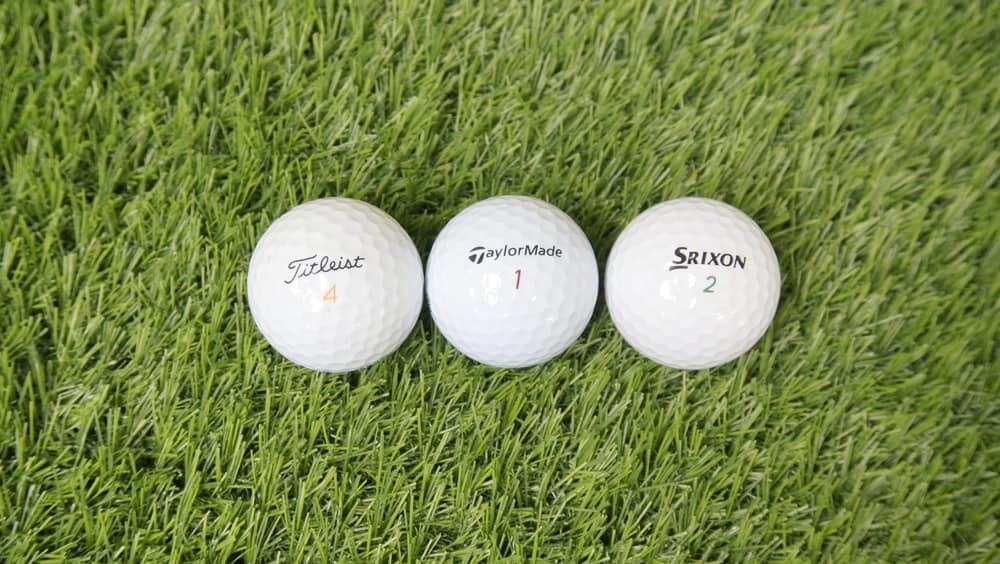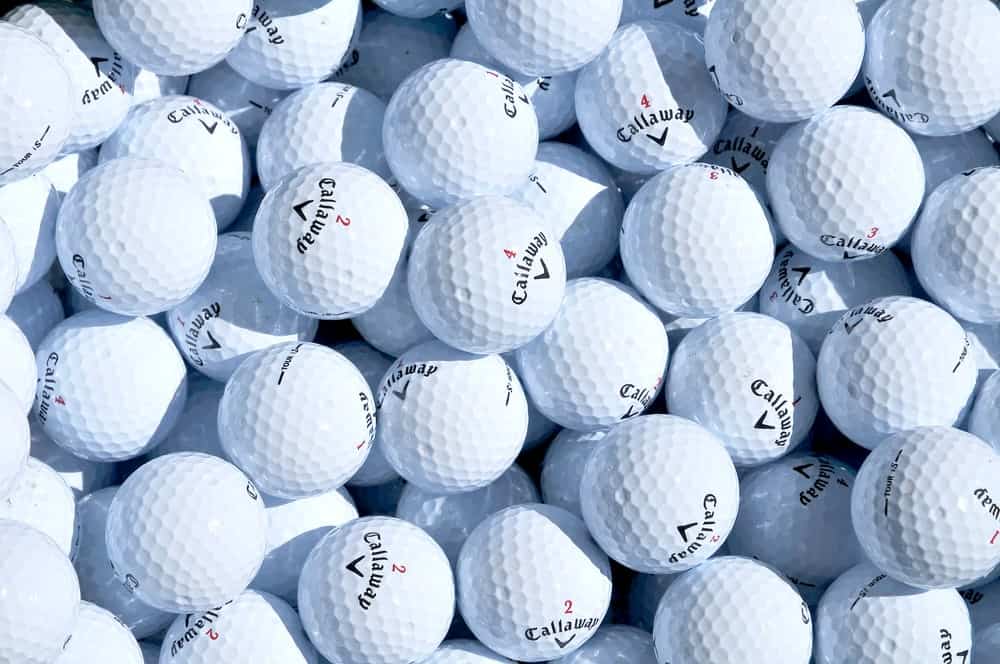What Do Numbers On Golf Balls Mean?
If you’re new to golf or a curious person in general, you may be wondering:
“What Do Numbers on Golf Balls Mean?”
The numbers on a golf ball can are used by golf ball manufacturers in a variety of ways. The most common reason for a golf ball number is to help identify one golf ball from another on the golf course.
Take an important tournament for example. If Rory McIlroy and Tiger Woods teed off from the same location with an unmarked modern golf ball, the odds are high that both balls would land in the fairway with similar distance. This is where golf ball numbers come into play. Each golfer can identify his/her ball easier if each ball in play has a different number.
Let’s dig into this question a little further.
Why Do Golf Balls Have Numbers on Them?
Understanding the Single Digit Number on Golf Balls
A golf ball manufacturer typically prints three things on their golf balls.
- Brand name
- Alignment aid
- A single digit number
When you see a single digit on a golf ball, it’s usually centered right below the brand name. The number is most often there for identification reasons. The single-digit numbers can range from 0-9, but 1-4 are the most common golf ball numbers.
The purpose of this single-digit number is to help differentiate your ball from those of your golfing buddies if you’re all using the same make of ball.
Let’s say that everyone at your fancy golf club plays with a Titleist Pro V1 or Pro V1x. Each person should choose a different single-digit numbered ball to distinguish theirs from all the other Pro V1 golf balls.
In most boxes of 12 golf balls, the manufacturer will package the balls in sleeves of 3 (4 sleeves of 3 balls = 1 dozen). Each sleeve of 3 balls will have a the same number printed on those 3 balls. For example:
- Sleeve 1 – #1 printed on it
- Sleeve 2 – #2 printed on it
- Sleeve 3 – #3 printing on it
…you get the idea.
If you buy recycled or second-hand golf balls, then you may not have an equal split of single-digit golf balls to choose form. In that case, you get to work with a random collection of single-digit numbers.
However, not everyone follows this process of using different single digits on their golf balls. Some players just mark their initials with a permanent marker pen or play with a colored golf ball to stand out from the crowd.
There are also golf ball “stamps” available to differentiate.
What Does a Two Digit Number on a Golf Ball Mean?
Some golf ball manufacturers push the envelope a bit with two-digit numbers to be more unique. Players can also customize their golf balls with a special play number if they’re willing to spend the extra cash. More on that later.
Back in the day, a double-digit number on a golf ball was used to indicate the compression rating of the golf ball. However, this printing move is rarely used in the modern game.
The compression of a golf ball relates to how tightly wound its core threads are, with low compression balls being softer and higher compression balls being harder.
In the past, a compression rate of 70-80 would indicate that the ball was softer and primarily suited for a woman, whereas a compression rating above this would signify that the ball was made for a man. This idea is dated, as many men prefer to play with a softer ball like the Callaway Supersoft or the Chrome Soft X.
Nowadays compression rating is primarily used to match with someone’s swing speed. If someone has a slower swing speed, they often benefit more from using a low compression ball.
As we mentioned before, this was a popular reason for double digit balls back in the 90s. These days you’ll rarely see two-digit numbers printed on a golf ball (unless you’re playing with recycled golf balls).
What Does a Three Digit Number on a Golf Ball Mean?
Another practice that used to exist, but isn’t very common anymore, is the three-digit number on a golf ball. In the past, this often signified how many dimples were on the golf ball.
I haven’t seen a 3 digit ball in the United States for at least a decade, so don’t be concerned if you can’t find a number like this on your golf balls. Golf ball manufacturers will often tell you how many dimples a ball has on the box or on their website.
The number of dimples on your golf ball can influence spin rate, ball speed, ball flight and maximum distance. Be sure to find the best golf ball to match your game.
If you do come across a three-digit number on the golf ball in the 100 range, this may actually specify the golf ball compression and not how many dimples are on the design.
Other Numbers On Golf Balls
Some golfers will choose specific numbers to be printed onto their golf balls for easy identification on the course. Other golfers will choose a more unique number that has special meaning to them or numbers they think bring good luck.
For a while, the Spanish golfer Sergio Garcia had 10 printed on his golf balls in honor of his favorite football team (Real Madrid) winning their 10th Champions League. However, he then changed his printed number to 49 in honor of the year his mother was born.
Justin Rose has ’99’ printed on his balls. His wife’s lucky number was ‘9’ so he thought having ’99’ printed would double his luck on the course. He also had the number printed in gold to commemorate the gold medal that he won at the Olympic Games in Rio in 2016.
If you’re using older golf balls, then you may come across colored numbers on them. Back in the day, these would signify the compression ratings of each ball, with red indicating a low compression golf ball and black numbers signifying a higher compression. However, this system isn’t used much anymore.
So in review: What do the numbers on golf balls mean?
In most cases, the number on a golf ball is used to help players sort out their ball from other balls on the course.
Sometimes the number on a golf ball is a custom choice. Players can have a ball personalized with their favorite number.
Older golf balls used numbers to signify compression or the number of dimples that the ball used, but this is no longer a common practice.


